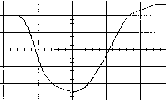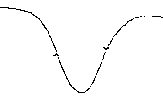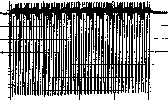The injector for the S-Band Test Facility at DESY is based on a conventional design. Equipped with a gridded cathode a 90kV thermionic gun produces 2µs long multibunchtrains with a repetition of up to 50Hz. The micropulses have a FWHM-length of less than 2.5ns containing a maximum charge of about 10nC (6.251010e-). For the purpose of wakefield related studies the interbunch spacing can be varied between 8ns, 16ns and 24ns, while keeping the average beam current within the bunchtrain constant at 300mA.
The bunching will be done by means of two single cell stainless steel buncher cavities running at 125MHz (1/24 subharmonic) and 500MHz (1/6 subharmonic) followed by two S-band travelling wave structures with different phase velocities.
Since summer 1995 the injector beamline is assembled
up to the 500MHz buncher as shown in figure 1. Four wall current
monitors, three button-type position monitors, a fluorescent screen,
a multihole aperture for the purpose of emittance measurement
and a faraday-cup at the end serve as diagnostic tools. Emphasizing
on the bunching behaviour, results from the operation of this
first part of the injector will be presented and compared with
predicted results from simulation codes.
 |
The S-Band Test Facility currently under construction at DESY investigates the feasibility of a large S-Band Linear Collider (SBLC) project. Delivered by an injector the beam will be accelerated by 4 (=1, 2/3-mode, 17MV/m) travelling wave sections of 6m length each, intersected by 3 quadrupole tripletts and fed by two 150MW/2µs S-band klystrons. Before being dumped at the end of the 40m long test facility the quality of the 400MeV/c beam will be measured using a spectrometer beamline including an OTR screen.
The SBLC-design is based on the same bunchtrain structure and current as used in the test facility except for the interbunch spacing. This value has been recently changed in the SBLC-parameterlist from 16ns to 6ns giving a reduced bunchcharge with looser tolerances in the main linac. From this point of view the test facility runs under more severe operation conditions. Before entering the first section of the testlinac the bunches have to be shorter than FWHM=16°3GHz=14.8ps and sufficiently relativistic with Ekin3MeV0.99. This guarantees a corresponding energy spread of less than 0.5% and no further longitudinal dynamics in the accelerating sections. Based on these requirements the injector was designed on a conventional scheme by means of EGUN and PARMELA calculations 1. Nevertheless it is a step into a challenging operation domain due to the combination of high bunchcharge and short interbunch spacing. The pulses are generated at a thermionic gun and compressed by means of two standing wave subharmonic bunchers SHB1 (125MHz/34kV) and SHB2 (500MHz/36kV) as well as two travelling wave structures (=0.6, 4cell, 2/3, 7MV/m and =0.95, 16cell, 8/9, 12MV/m). The latter one serves also for acceleration. Two 7MW klystrons will be used to supply both travelling wave bunchers individually. A low group velocity is necessary to build up the high gradient in the 16cell structure with only 7MW. Therefor the 8/9-mode was chosen. Starting with a 90kV gunpulse carrying 12nC (7.51010e-) in a FWHM-bunchlength of 2.5ns, PARMELA simulation predicts a compression by a factor of more than 250 to a pulselength shorter than 10ps with a transmission of better than 95%.
The injector hardware will be built up following the direction of the beam. In this process intermediate setups are used in order to commission major parts of the components. In the first half of 1995 a short beamline was installed for gun commissioning 2. A short review of the results is given in section III. In the next stage the injector was expanded by including SHB1 and SHB2 as can be seen in figure 1. Starting at the gun anode at z=0cm the beamline ends 219.3cm further downstream with a faraday-cup. The gap centers of both SHB's are sitting at z=75cm and z=191cm.
Since tuning concentrates on transmission and bunchlength most important diagnostic tools are 3 wall-current monitors 31.6cm behind the gun (CM1), 45cm behind SHB1 gapcenter (CM2) and 13.8cm behind of SHB2 (CM3). 4.8cm downstream of every CM button-type position monitors (BPM1,2,3) are installed. Transverse beamprofile can be measured at z=146.3cm with a fluorescent screen. Together with a multihole aperture (pepperpot), 86.7cm upstream of the screen, emittance measurement is possible and will be discussed in section IV. Instead of the screen a mirror can be put in at the same place offering the possibility of inspecting irregularities at the heated cathode while not pulsing the gun.
Getting shorter, the beampulses are transversely focussed by means of a longitudinal magnetic field created by solenoids AF4-AF12. With a level of 100Gauss around SHB1 the fieldstrength increases up to about 1000Gauss at the end of the beamline. Matching the beam coming from the gun is done by AF2 and AF3. The first solenoid AF1 centered at z=0 is powered reversely and used to compensate the magnetic field at the cathode as good as possible.
In addition 3 corrector dipoles in both planes, each 25cm long with a maximum field of 20Gauss, located behind the gun, behind SHB1 and in front of SHB2 are used to compensate orbit distortions and alignment errors. One has to keep in mind, that the resultant displacement of the beam depends on the strength of the longitudinal field Bz, since both the corrector field and Bz add like perpendicular vectors.
Pumping is done at the gun and both SHB's by means
of large 400l/s getterpumps. A vacuum valve (V1) at z=43.9cm can
separate the gun vacuum from the upstream system. The aperture
of the whole system has a diameter of 35mm, except at the gun,
where the hole in the anode measures only 20mm in diameter. This
setup was operated from autumn 1995 until end of june 1996. Bunch
compression results are presented in section V.
Production of 2µs long bunchtrains with 300mA average current is required. The single bunch FWHM-length has to be less than 2.5ns in order to be cleanly accepted by SHB1. Depending on the chosen interbunch spacing the single bunchcharge has to be at least:
These bunches are produced at a 90kV thermionic gun operated at air and equipped with a gridded cathode of the EIMAC Y796 type. The gun geometry was modelled with the EGUN code. At a 34mm cathode anode distance it results in a calculated perveance of 0.22µA/V1.5. At 90kV this is equivalent to 6A spacecharge limited current, which was experimentally proven when driving the gun with a testpulser that creates µs-long single pulses.
Extraction of bunchtrains consisting of short pulses is achieved by means of a special pulser that is housed inside the 240mm long gunceramic closely to the guncathode. The input pulse is amplified with a three stage triode circuit interconnected by ferrite loaded coaxial transformers in which the third triode with its anode directly connected to the guncathode operates in a current source mode. Supplying the pulserinput with 2ns wide pulses of 60V peak and the desired timestructure the gun produces the required bunchtrains. Measured at CM1 (see fig. 2a) the beam pulses have a FWHM-length of typically 2.2ns, a subnanosecond risetime and a peakcurrent of up to 4.5A, which is less than the gun capability, since it is limited by the current output of the last triode stage. Nevertheless the bunches carry a charge of about 10nC (6.251010e-) giving a 40% safety margin with respect to 7.2nC as desired in 24ns mode.
The amplitudes of all bunches as measured at CM1 are stable within less than 4% over the whole bunchtrain in 24ns mode. The same stability is achieved at 16ns or 8ns operation except at the beginning of the train. In the 16ns mode the first pulse has a 15% increased amplitude and in the 8ns mode there is a drop down to 70% over the first 3 pulses after reaching equilibrium level. This effect can be explained by saturation of the interstage transformer cores, which can not relax totally when pulse spacing is getting shorter. Since the required bunchcharge is inversely proportional to the interbunch spacing the safety margin is even higher at 16ns or 8ns operation.
For the S-Band Test Facility this scheme of bunchtrain
production has been sucessfully commissioned and fulfills all
the requirements in terms of time structure, bunchcharge as well
as stability of intensity and timing. Not being tested yet it
may even work in 6ns operation mode as proposed for SBLC. If not
applicable a resonant driving circuit for the gun can be used
for this purpose.
At z=59.6cm a pepperpot can be driven into the beamline. It is made from a 5mm thick copper plate drilled with 0.4mm holes on the vertical, horizontal and both diagonal axis in a radial distance of every 2mm starting from the center hole. These holes define the position of the beamlets. Their angular width can be calculated from the corresponding spotsize at the screen, which is located l=86.7cm further downstream. From both informations the emittance at the position of the pepperpot can be derived. For simplicicity in most applications a drift space is chosen between pepperpot and screen 3.
Unfortunately the large getterpumps create a transverse magnetic strayfield of the order of 2Gaussm at the beam axis, which totally prevents transmission between pepperpot and screen without any solenoidal field. Thus the emittance measurement was made within a longitudinal magnetic field Bz 4. If Bz=const the transfermatrix of a solenoid with length l can be applied. Unity matrix is achieved when kl/2=n, with k=eBz/p, n=1,2,..., electron charge e and beam momentum p. In this case the screen shows a 1:1 picture of the pepperpot but the information on the beamlet angles is not accessible. If kl/2=(n+1/2) all the elements of the transfer matrix are zero, except the ones on the secondary diagonal. In this case the screen looks at the focal plane, i.e. angles at the pepperpot are translated into displacements at the screen. With n=1 corresponding to Bz=114.5Gauss emittance measurement was made in the test facility. From the horizontal (vertical) width of the spotsize at the screen the vertical (horizontal) angular width of the corresponding beamlet at the pepperpot was derived. Particular attention has to be paid on the right correspondence, since the transverse plane is rotated by 90° around the z-axis in this situation. When moving the pepperpot horizontally the picture on the screen moves vertically. Measuring the area F=n,rms of the reconstructed x-x' phase space gave a normalized rms emittance n,rms of about 3mmmrad at the position of the pepperpot. Since this value was not corrected for additional effects contributing to the spotsize like spacecharge and finite pepperpot hole diameter, it can be regarded as an upper limit of the emittance.
The typical bunchcharge during this measurement was
7nC, resulting from a 2ns gunpulse of 3.5A peak. Starting with
1.8mmmrad at the gun exit the PARMELA predicted normalized rms
emittance at the pepperpot is 6.8mmmrad for a bunchcharge of 7nC.
The input parameters for the PARMELA simulation were derived from
EGUN calculations with a spacecharge limited current of 6A and
absence of magnetic field over the whole gun area. The simulations
do not represent the experiment very well which might be one reason
for the discrepancy of more than a factor of 2.
|
|
| |
According to PARMELA calculations SHB1 and SHB2 have to run at a gapvoltage of 34kV and 36kV respectively. In that case the program predicts a bunch of 200ps FWHM-length at the position of CM3. This bunch can be cleanly captured by the 4cell travelling wave S-band buncher with its first cell centered at z=215cm. The arrival time of the bunch at CM3 changes when the rf-phase is varied in SHB1 or SHB2. From these measurements the gapvoltage U, an information on the absolute phase setting with respect to the beam and together with the measured power P flowing into the cavity the absolute shuntimpedance Rs=U2/(2P) was experimetally determinded. The quality factor Q0 was measured with a spectrum analyzer. The results as shown in table 1 agree within 10% with MAFIA calculations.
Optimizing phases and amplitudes of both SHB's a bunch of 300ps FWHM-length with 26A peakcurrent giving 7.8nC was achieved at CM3 (see fig. 2b) for a typical gunpulse (2.2ns/4.5A) of about 10nC. Four 50 resistors are soldered across the ceramic gap of CM3. Together with the gap-capacitance an upper frequency limit around 1-1.5GHz was estimated by the design engineer of this monitor. Combined by a 4 to 1 circuit of 2 GHz bandwidth (bw) the monitor signal is guided by a 12m long 7/8'' air dielectric Flexwell coaxcable with a 3db bw of 5GHz on to a 6GHz oscilloscope (tektronix TDS 684B). Taking into account the measured cable attenuation of 0.8db at 1GHz, which is around the fundamental for a 300ps pulse, the charge transmission up to CM3 is better than 85%. As a result of the bandwidth limits, mainly at the monitor itself, a pulse shorter than 300ps is not measurable. The answer whether the real bunchlength agrees with the expected 200ps will be given in the next stage of the injector extended by the S-band buncherstructures. As expected the phases of both SHB's have been set within 5° around zero crossing. Running at 30kV the SHB1 amplitude agreed fairly well with the predictions, but SHB2 operated at 52kV instead of the expected 36kV.
 |
 |
 |
 |
The first part of the Injector for the S-Band Test
Facility including the gun and two subharmonic buncher cavities
(SHB) was successfully commissioned. The gun produces 2µs
long bunchtrains with different interbunch spacing. Each single
pulse with a 2.2ns FWHM-length carries up to 10nC of charge. Measured
with the pepperpot technique inside a constant solenoidal field
the normalized rms-emittance was 3mmmrad being a factor 2.2 smaller
than expected. Optimized for bunching the gapvoltages differ from
PARMELA predictions by -12% in SHB1 and +44% in SHB2. They were
measured by a time of fligth method taking advantage of the 90kV
nonrelativistic beam. 200ps long pulses are expected after compression
by both SHB's. Bandwidth limited by the wall current monitor 300ps
long signals and a transmission better than 85% were observed.
Otherwise heavily affected by beamloading a feedforward-system
keeps the cavity parameters almost constant over the whole train
of pulses.
[1] The Injector for the S-Band Test Linac at DESY, M. Schmitz, A.D. Yeremian, Proceedings of the 1994 International Linac Conference, p71-73, Tsukuba, Japan
[2] First Tests at Injector for the S-Band Test Facility, M. Schmitz et al., Proceedings of the 1995 Particle Accelerator Conference, p.929-931, Dallas Texas, USA
[3] Beam Emittance Measurement by the Pepperpot Method, J.G. Wang, D.X.Wang, M. Reiser, NIM A307 (1991), p.190-194
[4] Inbetriebnahme der Elektronen-Gun des S-Band Testlinac und Bestimmung der Strahleigenschaften, R. Walther, Fachhochschule Ostfriesland, Emden, Germany